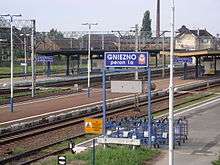Gniezno railway station
Gniezno railway station is a railway station serving the city of Gniezno, in the Greater Poland Voivodeship, Poland. The station is located on the Poznań–Skandawa railway and Oleśnica–Chojnice railway. The train services are operated by PKP, Przewozy Regionalne and Koleje Wielkopolskie.
Gniezno | |
|---|---|
| Railway Station | |
_Lichen99.jpg) Gniezno railway station | |
| Location | Gniezno, Greater Poland Voivodeship Poland |
| Coordinates | 52°31′47″N 17°36′13″E |
| Operated by | PKP Przewozy Regionalne Koleje Wielkopolskie |
| Line(s) | Poznań–Skandawa railway Oleśnica–Chojnice railway |
| Platforms | 5 |
| History | |
| Opened | 26 May 1872 |
| Rebuilt | 2012-2014 |
| Location | |
 Gniezno Location within Poland | |


History
The history of the railway station in Gniezno started on 30 November 1867 when, as a result of intense negotiations, a contract to build a railway from Poznan by Gniezno and Inowrocław to Torun and Bydgoszcz was signed. The railway station in Gniezno was one of the most important on the route to Bydgoszcz and Torun. Once the decision had been made and the optimal route had been studied, the first excavations were recorded in September 1868, at the area of the current railway station in Trzemeszno.
After four years of construction of the line, the grand opening of the station took place on 26 May 1872, when the first train ran on the new line. The first passenger service was inaugurated on 1 July 1873. The construction of a second railway line connecting Gniezno with Oleśnica was approved on 17 June 1872 with the official opening on 30 June 1875.
Gniezno railway station is located at the 50th kilometer mark on the line from Poznan to Torun, on the south side of the city of Gniezno. The most important building opposite the station has become a powerful addition to the expansion of the railway station, a depot. The locomotive depot has been rebuilt several times and it has now become a roundhouse, one of Europe's largest with 24 roads coming from it. Nowadays it is open for tourists[1].
In the years 1908 to 1911, as a result of numerous transformations both in the late nineteenth and early twentieth century, the technical and operational activity at the station expanded.
With the outbreak of World War II, the city of Gniezno was engaged in the raids. In September 1939 the railway lines were damaged or destroyed. On 6 September, as a result of the bombing, the roundhouse and several steam locomotives were destroyed. In 1940, as a result of the meeting of the Special Committee approved the plan "Otto", which aimed at the restoration and reconstruction of railways, modernization and expansion of railway stations and in the case of Gniezno modernization and expansion of the roundhouse. Thanks to the program, "Otto" in addition to the expansion and modernisation of railway lines and the construction of footbridges and roundhouse roads, telecommunication installations, reconstruction and electrification of railway sidings and the depot.
But the same program "Otto" did not finish there as the freight yard at Gniezo was expanded to relieve Poznan. The history of the railway station and roundhouse was written in 2010 in the book Miron Urbaniak Fri. "The historic railway station Gniezno" and the book of Thomas Tomkowiak Fri. "Secrets of Gniezno".[2]
Modernisation
In 1967-1968 the station was modernised with new platforms. Between 2012-2014, the station had a complete modernisation and reconstruction of the current station building and surrounding areas.
Train services
The station is served by the following service(s):
- EuroCity services (EC) Berlin - Frankfurt (Oder) - Rzepin - Poznan - Bydgoszcz - Gdansk - Gdynia
- Intercity services Wroclaw - Leszno - Poznan - Inowroclaw - Bydgoszcz - Gdansk - Gdynia
- Intercity services Krakow - Lodz - Kutno - Konin - Poznan - Inowroclaw - Bydgoszcz
- Intercity services Wroclaw - Leszno - Poznan - Inowroclaw - Bydgoszcz - Gdansk - Gdynia
- Intercity services Wroclaw - Leszno - Poznan - Inowroclaw - Torun - Olsztyn - Bialystok
- Intercity services Zielona Góra - Zbąszynek - Poznan - Inowroclaw - Bydgoszcz - Gdansk - Gdynia
- Intercity services Zielona Góra - Zbąszynek - Poznan - Inowroclaw - Torun - Olsztyn
- Intercity services Jelenia Gora - Wroclaw - Jarocin - Poznan - Inowroclaw - Bydgoszcz - Gdansk - Gdynia
- Regional services (R) Poznan - Gniezno - Mogilno - Inowroclaw - Bydgoszcz
- Regional services (R) Poznan - Gniezno - Mogilno - Inowroclaw - Torun
- Regional services (KW) Poznan - Gniezno
| Preceding station | PKP | Following station | ||
|---|---|---|---|---|
Poznań Główny toward Berlin Hbf | EuroCity | Inowrocław toward Gdynia Główna |
||
towards Wrocław Główny | PKP | towards Gdynia Główna |
||
towards Kraków Główny | PKP | Mogilno towards Bydgoszcz Główna |
||
towards Wrocław Główny | PKP | towards Białystok |
||
towards Zielona Góra | PKP | towards Gdynia Główna |
||
towards Zielona Góra | PKP | Mogilno towards Olsztyn Główny |
||
towards Jelenia Góra | PKP | towards Gdynia Główna |
||
| Preceding station | Przewozy Regionalne | Following station | ||
Pierzyska toward Poznań Główny | PR | Jankowo Dolne toward Bydgoszcz Główna |
||
Pierzyska toward Poznań Główny | PR | Jankowo Dolne toward Toruń Główny |
||
| Preceding station | Following station | |||
Pierzyska toward Poznań Główny | KW | Terminus |
External links

References
- "Parowozownia Gniezno". www.parowozowniagniezno.pl (in Polish). Retrieved 2017-07-19.
- Miron Urbaniak, History of the railway station in Gniezno, ed. 2010
- This article is based upon a translation of the Polish language version as of April 2016.